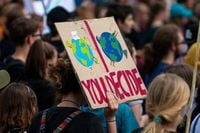On April 25, 2025, Sophie Hermans, the Minister of Climate and Green Growth, unveiled a new set of climate plans aimed at reducing greenhouse gas emissions in the Netherlands. The ambitious goal is to cut emissions by 55 percent by 2030 compared to 1990 levels. However, the plans have sparked mixed reactions, raising questions about their adequacy in meeting this critical target.
The climate package presented includes measures across various sectors, including industry, transportation, and construction. A notable feature is the introduction of tax benefits for electric car drivers starting in 2027, alongside adjustments to road tax based on the surface area of vehicles. Homeowners with energy labels E, F, or G will also benefit from cheaper loans to improve their homes' energy efficiency, coupled with additional subsidies for heat pumps.
Despite these initiatives, many experts and environmental advocates express skepticism about whether these measures will suffice. Marjan Minnesma, director of the environmental organization Urgenda, criticized the plans, stating, "She will not meet her targets. A lot of things are being pushed back. Some measures that this cabinet had scrapped are being reinstated." While she supports the push for heat pumps and electric vehicles, she feels a lack of vision is evident in the overall strategy. "We are not looking ahead. I also miss the corresponding budget to ensure that we help the companies of the coming century rather than prolonging outdated ones," she added.
The industry is set to receive substantial support, with 8 billion euros allocated for making businesses more sustainable. This funding aims to address rising energy costs, which have been a significant concern for industrial players. Vincent van der Chijs, chairman of the association for port and industrial companies Deltalinqs, welcomed the measures, stating, "These are good steps to restore trust in the industry. Looking at some of the measures, it looks really good." He highlighted the potential for capturing and storing CO2 underground as a positive development.
However, there are concerns regarding the CO2 levy that companies must pay for emissions. Although the levy will not increase, it will not be abolished, which Van der Chijs deems "unjust" given the challenges companies face, such as grid congestion and nitrogen issues that hinder progress. He believes the government should reconsider this levy.
As the Netherlands strives to meet its 2030 emissions target, the current trajectory shows a significant gap. Currently, the country emits around 150 megatons of CO2, while the target is set at just 103 megatons. The Planbureau voor de Leefomgeving has calculated that the likelihood of achieving this goal is only 50 percent, requiring a reduction of at least 16 megatons. The additional measures proposed by Hermans are expected to save about 10 megatons, leaving a considerable shortfall.
The opposition has been vocal in its criticism, arguing that the government’s approach incentivizes continued pollution. Suzanne Kröger of GroenLinks-PvdA remarked, "The fire is in climate policy. This cabinet makes one fossil decision after another, cuts back on the green economy, and leaves people out in the cold. The minister might as well remove the words climate and green from her title." Conversely, Van der Chijs argues that the measures are necessary to maintain international competitiveness, stating, "This also leads to a weaker competitive position. Something must be done to ensure a level playing field with neighboring countries."
Another point of contention is the government's investment in nuclear energy. Minnesma criticized the allocation of 14 billion euros for nuclear energy, which she claims the market does not want. She believes this funding would be better spent on immediate climate actions like insulation, heat pumps, and electric vehicles, rather than on nuclear projects.
In her press conference, Hermans acknowledged the challenges ahead, stating, "We have been confronted with the facts in recent months that we need to become independent, including in our energy supply." She emphasized the importance of balancing energy independence with climate goals, asserting, "Without attention to implementation and affordability, you will get stuck even further."
As the political landscape continues to evolve, the coalition's commitment to climate action appears to be wavering. In prior discussions, it was evident that support for stringent climate measures was lacking. The recent budget cuts to the Climate Fund, which have been utilized to lower energy taxes for households and businesses, further illustrate this trend. The coalition has also reduced the national CO2 levy for industry and horticulture, signaling a retreat from ambitious climate commitments.
Looking ahead, the success of Hermans' climate plans remains uncertain. The Planbureau voor de Leefomgeving's earlier estimates suggested that the Netherlands might only achieve a 55 percent reduction in emissions by 2035, five years later than intended. The current measures, which include increased support for carbon capture and storage (CCS), may not produce substantial results until after 2030.
In summary, while Minister Hermans has introduced a range of initiatives aimed at reducing emissions, the effectiveness of these plans in meeting the 2030 targets remains in doubt. As environmental advocates and industry representatives weigh in, the path forward for the Netherlands’ climate policy is fraught with challenges, and the window for decisive action is narrowing.






